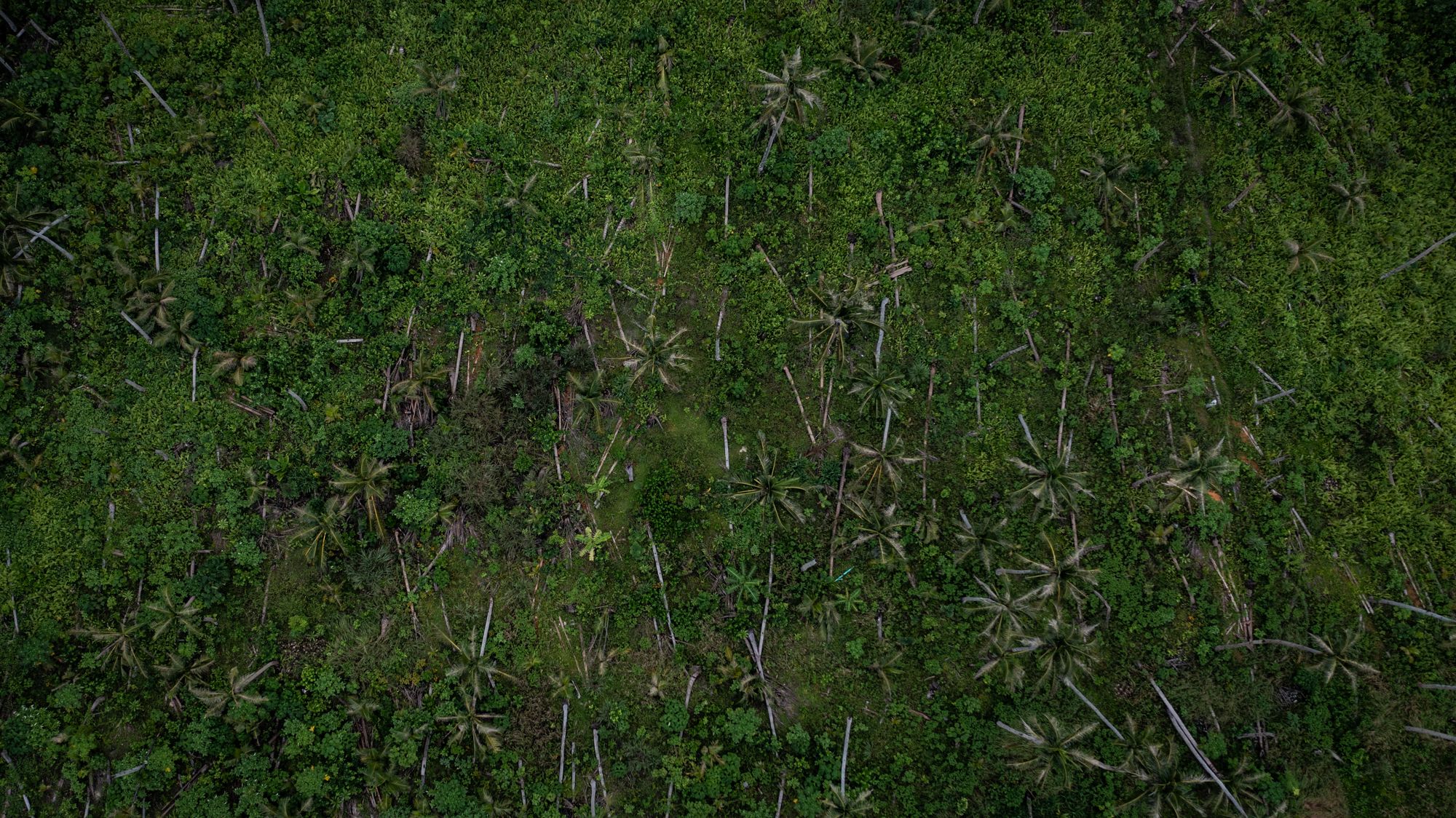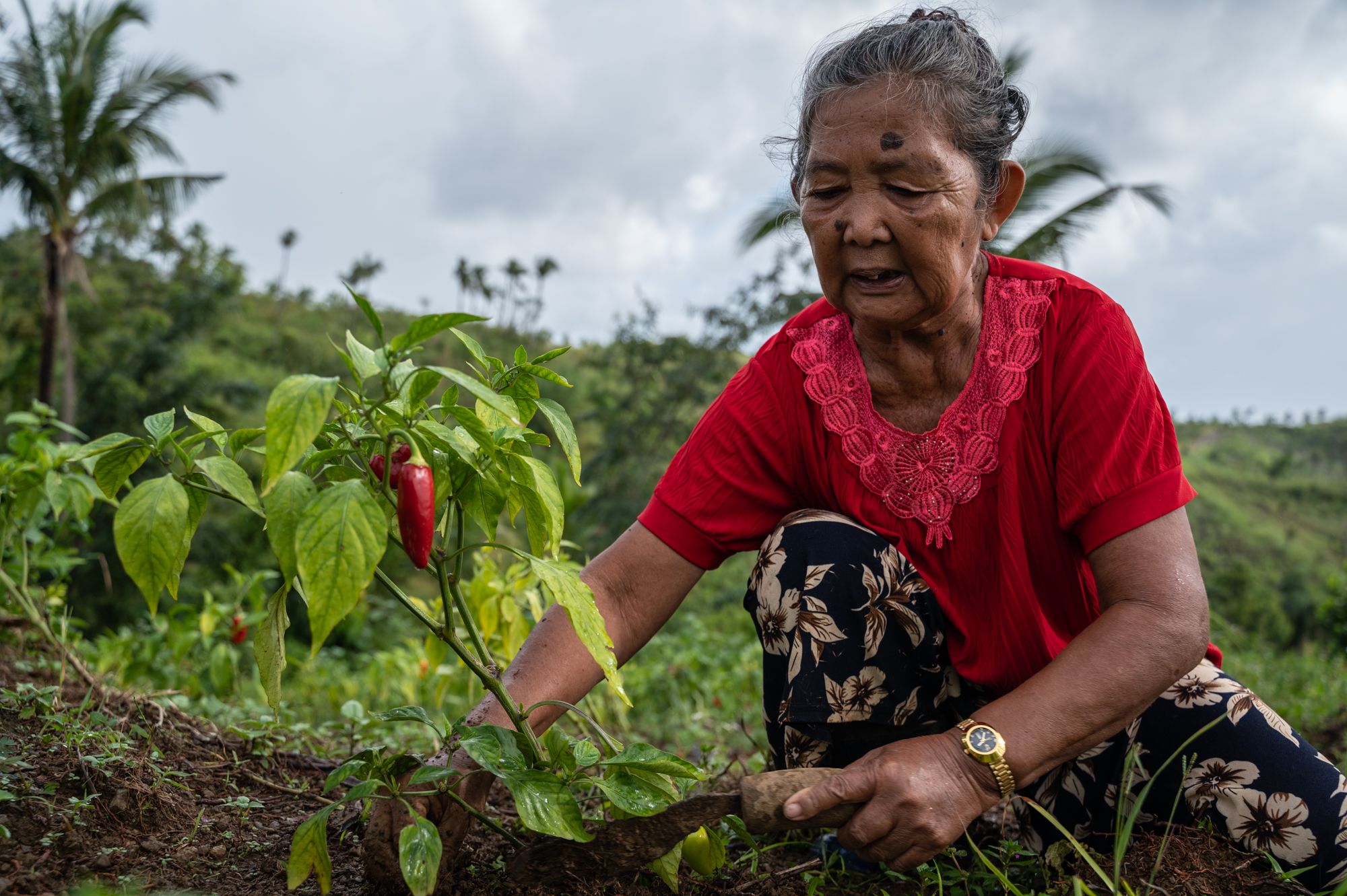Sowing Seeds of Hope in the Dinagat Islands

In a hilly village in Basilisa, Dinagat Islands, Vergelia Buenaflor, 67, was sharing lunch with her husband, Lupi Buenaflor, 68, after a morning of tending to their crops and livestock. The aroma of steamed rice filled the small hut they were living in, while the elderly couple picked some ripe bananas to complete the meal.

Vergelia Buenaflor was originally from Cebu Province. In 1978, she and her husband decided to go to Dinagat Islands to join a faith-based mission. She decided to settle down on top of a hill in Basilisa, looking over the headquarters of their church in San Jose, the capital town of Dinagat.
Vergelia Buenaflor was originally from Cebu Province. In 1978, she and her husband decided to go to Dinagat Islands to join a faith-based mission. She decided to settle down on top of a hill in Basilisa, looking over the headquarters of their church in San Jose, the capital town of Dinagat.
The steamed rice-banana combo is a meal fixture for Vergelia and her husband. Options are few as income from coconut farming, the bread and butter of the family, is practically zero. The 100 coconut trees they farmed in a three-hectare land were damaged by Super Typhoon (ST) Rai (locally named Odette) last December 16, 2021.

A year after ST Rai made landfall in Dinagat, many farmers and their families are still reeling from the devastation they suffered from the typhoon. Coconut is one of the major agricultural products of Dinagat Islands Province. The copra industry helps the farmers put food on their tables. But the Province suffered P1.1 billion worth of agricultural damage when ST Rai struck, damaging 1.4 million coconut trees, with risk of infestation that can aggravate the farmers’ losses.
The Buenaflors' coconut trees are part of those numbers.





“We need to cut them down because large portion of the roots were uprooted partially, and they would not bear any more fruits. There’s also the risk of coconut infestation if we just let them decay. But we cannot do it alone because we are both old and cannot do much labor. We do not have money to pay for wood cutters,” said Vergelia.

Banana trunks were cut after the harvest so that a new leaf will sprout in the lower trunk near the roots. This will allow for a new banana seedling to grow that can be replanted in the farm.
Banana trunks were cut after the harvest so that a new leaf will sprout in the lower trunk near the roots. This will allow for a new banana seedling to grow that can be replanted in the farm.
Despite the old age, Vergelia and her husband are sharing the work in their farm equally. They earn an average of P8,000 every quarter for a 250-kilogram copra that they would sell to Surigao City at P32 per kilo. Her family’s earnings vary depending on the buying price of copra in the market. When the price of corpa hits an all-time low, Vergelia can only sell it at P5 per kilo, and she would take home P750 for a three months’ worth of work.







Among the vegetable seeds that Vergelia and her husband received from UNDP were okra, eggplant, bell pepper, chili, peanuts, cassava, and sweet potato. Every eight to 10 weeks, she can harvest bell pepper, okra, and eggplant to sell in their neighborhood. She would also dry seeds for another planting season.
After the typhoon, Vergelia and her family get by through relief aid and from what she can salvage from the farm. They continue to raise livestock including pig and chicken and started to cultivate the land for other crops like banana. From their meager harvest, she would barter them for a 25-kilogram sack of rice. This has been their way of life for a year since the typhoon destroyed their farm.
Depending on the variant, farmers need to wait at least five years before they can harvest coconuts. But farmers do not have the luxury of time to wait for the trees to grow and bear fruit. Planting and growing other high value crops become necessary so they can earn money to support their families.
The United Nations Development Programme (UNDP) conducted an assessment in Dinagat Islands to determine the most viable, high yielding crops that will be suitable for intercropping in coconut farms, through its local partner Philippine Grassroots Engagement in Rural Development Foundation. The knowledge and familiarity of the farmers in growing these crops were also considered.
In the third quarter of 2022, Vergelia was one of the 273 farmers who received fertilizers and coconut seedlings from UNDP in three municipalities including Tubajon, Basilisa, and Cagdianao. Aside from coconut seedlings, she also received vegetable seeds such as peanuts, bell pepper, eggplant, and okra as well as sweet potato and cassava cuttings – all considered as fast and high yielding crops.

Other farmers in Dinagat Islands received the same assistance including the women farmers in Tubajon. Marife Gallo, 57 years old, is the chairperson of the Tubajon People’s Council, a consortium of associations of small farmers and fishers in their municipality.
Most of the produce of the local farmers here are for family consumption only. Excess harvests are usually sold to neighbors or nearby communities at a much lower price.
“As much as we want to sell it to taboan (market), the transportation cost going to the town proper is expensive,” shared Marife.
Leading the small farmers in Tubajon, Marife will always attend workshops and trainings organized by the government and other organizations. She proactively seeks opportunities where small farmers like her can benefit, especially assistance and programs to help them recover and become more resilient from disasters. But aside from the learnings she acquires from those workshops, Marife jokingly said that it’s also a pass for a free meal to any farmer who tried to make ends meet daily.

As part of its Typhoon Odette Recovery efforts, UNDP Philippines distributed 15,000 coconut seedlings to 273 farmers in three municipalities in Dinagat Islands.
As part of its Typhoon Odette Recovery efforts, UNDP Philippines distributed 15,000 coconut seedlings to 273 farmers in three municipalities in Dinagat Islands.

Marife Gallo shared and represented the plight of her fellow small farmers that were badly affected by Super Typhoon Rai last December 2021. Being a single mother, she raised her daughter and supported her parents through farming.
Marife Gallo shared and represented the plight of her fellow small farmers that were badly affected by Super Typhoon Rai last December 2021. Being a single mother, she raised her daughter and supported her parents through farming.
Prior to the typhoon, Marife can harvest 800 coconuts from their 167 trees, and can produce 200 kilograms of copra. But the typhoon damaged at least 50 coconut trees in their farm. The harvest season came and went, and Marife gathered only 200 coconuts to make 89 kilograms of copra.


Cultivating rice fields after a super typhoon might be a daunting task for Marife but she did not back down in every day hassle in their farm. She is looking forward to plant and harvest new sacks of rice in the next four months.
Cultivating rice fields after a super typhoon might be a daunting task for Marife but she did not back down in every day hassle in their farm. She is looking forward to plant and harvest new sacks of rice in the next four months.

Armed with her bolo, Vergelia goes to the farm every day to pull out the weeds and make sure that all vegetable plots are tended to. This daily farm work of women are not commonly accounted in the agriculture sector.
Armed with her bolo, Vergelia goes to the farm every day to pull out the weeds and make sure that all vegetable plots are tended to. This daily farm work of women are not commonly accounted in the agriculture sector.
These days, Marife is singlehandedly managing their farm. Her parents were already old to do the hard labor while her only daughter lives in another town. They have eight small packets of rice fields, which can provide one and a half sack of rice harvest every four months.
Like Vergelia, she also received 50 coconut seedlings, five assorted vegetable seeds, six sets of fertilizers, one bag of peanut seeds, 200 sweet potato cuttings, and 240 cassava cuttins. While Marife fears that another strong typhoon will destroy what remains in their farm, she and the other farmers do not have any choice but to move forward.
“(Typhoon) Odette took a lot from us. The overflow from the nearby river drowned our livestock and harvests. It’s the first time we experienced such a strong typhoon. But small farmers like me cannot afford to stop. I have to take care of our farm while taking care of my family, so we won’t get hungry,” Marife said.
In the 2016 data of the Philippine Statistics Authority, 25% of workers in the agriculture sector were women. However, this number may not accurately translate the contribution of women since their works are commonly viewed as extension of household chores and unpaid family work. This is one of the main reasons why women’s contributions to the agriculture remain unaccounted and under value.
A few months after receiving the farming assistance, Vergelia and her husband started to harvest their first produce from the seeds they received from UNDP.
Within eight to 10 weeks since planting, they were able to barter their harvest of bell pepper, chilis, eggplant, and tomatoes to the market so they have money to buy other basic necessities such as rice.
From the training provided also by UNDP, they learned to plot a simple farm plan to strategically maximize the land area given their limited resources. They were taught community seed banking to save on cost of procuring commercial seeds in preparing new batch of vegetable seeds for another planting season.
While waiting for the coconut seedlings to mature and bear fruits within a few years, the vegetables harvests and other crops will help Vergelia and her family gradually recover from the losses they suffered from the typhoon, and earn a decent amount to get by in their daily lives. [end]




Both Marife and Vergelia hope that the coconut farming industry in Dinagat Islands will be able to recover in the next coming years.
Words: Remelizza Joy S. Dejucos
Photos: Gab Mejia
